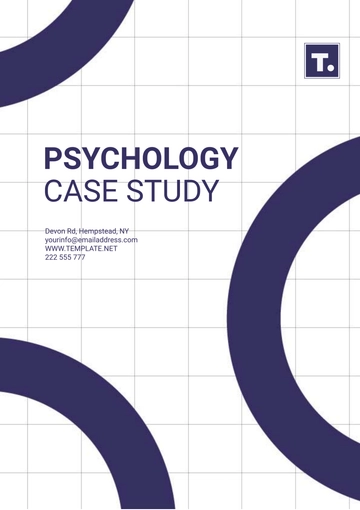Free Counseling Case Study

I. Introduction
[Your Company Name] is pleased to present a counseling case study focused on the successful treatment of anxiety using Cognitive Behavioral Therapy (CBT). As a leading provider of mental health services, [Your Company Name] is committed to delivering evidence-based treatments to improve the well-being of our clients.
In this case study, we explore the journey of a client struggling with severe anxiety and the therapeutic interventions employed to facilitate recovery. Samantha Smith, a 32-year-old woman, sought counseling at [Your Company Name] due to debilitating anxiety symptoms that were significantly impacting her daily life. She reported experiencing persistent worry, racing thoughts, difficulty concentrating, muscle tension, and frequent panic attacks.
[Client Name] expressed frustration and hopelessness, as her anxiety prevented her from engaging in social activities, pursuing career opportunities, and maintaining healthy relationships. Recognizing the severity of her symptoms, [Client Name] was motivated to seek professional help and was open to exploring different therapeutic approaches.
II. Background Information
A. Client Background
Name: Samantha Smith
Age: 32
Gender: Female
Occupation: Marketing Manager
Presenting Concerns: Severe anxiety, panic attacks, avoidance behavior
History of Presenting Concerns: Symptoms have been present for the past 5 years, progressively worsening over time
Psychosocial History: Single, lives alone, strained relationship with family, limited social support network
Medical History: No significant medical issues were reported, no history of substance abuse
B. Assessment
Upon initial assessment, Samantha Smith scored high on measures of anxiety severity, including the Generalized Anxiety Disorder 7-item (GAD-7) scale and the Beck Anxiety Inventory (BAI). She exhibited symptoms consistent with Generalized Anxiety Disorder (GAD) and Panic Disorder.
Additionally, Samantha Smith displayed maladaptive cognitive patterns, such as catastrophic thinking and overestimation of threat, contributing to the maintenance of her anxiety symptoms. Collaboration with Samantha Smith revealed underlying beliefs related to perfectionism, fear of failure, and concerns about social evaluation.
III. Treatment Plan
A. Goals of Treatment
Reduce Anxiety Symptoms: Decrease the frequency and intensity of panic attacks, and alleviate generalized anxiety symptoms.
Improve Coping Skills: Develop effective coping strategies to manage stress and reduce avoidance behavior.
Challenge Maladaptive Beliefs: Identify and challenge cognitive distortions contributing to anxiety.
Enhance Self-Efficacy: Increase confidence in handling challenging situations and building resilience.
B. Therapeutic Interventions
Cognitive Restructuring: Utilize cognitive restructuring techniques to challenge irrational beliefs and replace them with more adaptive thoughts. Employ cognitive-behavioral techniques such as examining evidence, identifying cognitive distortions, and reframing negative thoughts.
Exposure Therapy: Gradual exposure to feared situations to desensitize Samantha Smith to anxiety-provoking stimuli. Develop an exposure hierarchy to systematically confront feared objects or situations, starting from least to most anxiety-inducing.
Relaxation Techniques: Teach Samantha Smith relaxation techniques such as diaphragmatic breathing, progressive muscle relaxation, and mindfulness meditation to reduce physiological arousal and promote emotional regulation.
Behavioral Activation: Encourage engagement in pleasurable and meaningful activities to counteract avoidance behavior and increase positive reinforcement.
Homework Assignments: Assign homework exercises to reinforce therapeutic concepts learned in session and encourage generalization of skills to real-life situations.
IV. Progress and Outcome
Throughout 12 sessions, Samantha Smith demonstrated significant improvement in her anxiety symptoms and reported a reduction in the frequency and intensity of panic attacks. She exhibited enhanced coping skills and greater self-awareness of her maladaptive thinking patterns. Through cognitive restructuring exercises, Samantha Smith was able to challenge and reframe her negative beliefs, leading to a more balanced perspective on her experiences.
Gradual exposure to feared stimuli allowed Samantha Smith to confront her anxieties and build confidence in her ability to cope with discomfort. After treatment, Samantha Smith reported a marked improvement in her overall quality of life. She expressed feeling more empowered to face challenges and engage in activities that were previously avoided due to anxiety. Samantha Smith demonstrated resilience and a willingness to continue utilizing the skills learned in therapy to maintain her progress.
Follow-up assessments indicated sustained gains in symptom reduction and improved psychosocial functioning. The successful outcome of this case underscores the efficacy of CBT in treating anxiety disorders and highlights the importance of collaborative therapeutic work in facilitating recovery.
V. Conclusion
This counseling case study illustrates the effective application of Cognitive Behavioral Therapy in addressing severe anxiety symptoms. Through a combination of cognitive restructuring, exposure therapy, and skill-building exercises, Samantha Smith was able to overcome debilitating anxiety and regain control over her life.
The collaborative efforts between the client and therapist yielded positive outcomes and underscored the importance of evidence-based interventions in mental health treatment. [Your Company Name] remains committed to delivering high-quality counseling services that promote healing and well-being for individuals struggling with mental health concerns.
Prepared by:
Dr. [Your Name]
Contact Details:
[Your Company Email]
[Your Company Number]
[Your Company Name]
- 100% Customizable, free editor
- Access 1 Million+ Templates, photo’s & graphics
- Download or share as a template
- Click and replace photos, graphics, text, backgrounds
- Resize, crop, AI write & more
- Access advanced editor
Unlock the potential of your counseling practice with our Counseling Case Study Template, offered by Template.net. This customizable, downloadable, and printable template empowers you to organize and showcase your client success stories effectively. Crafted to streamline your workflow, it's editable in our intuitive AI Editor Tool, ensuring seamless customization. Elevate your counseling journey with this essential resource today.





























